

by Brian Packard 2014
A concept vehicle or show vehicle is a car made to showcase new styling and/or new technology. They are often shown at motor shows to gauge customer reaction to new and radical designs which may or may not be mass-produced. General Motors designer Harley Earl is generally credited with inventing the concept car, and did much to popularize it through its traveling Motorama shows of the 1950s.
Before I tell you about Harley Earl, let me show you some of the concept or "prototype" cars he envisioned and influenced.
Prototype Cars That Never Made It
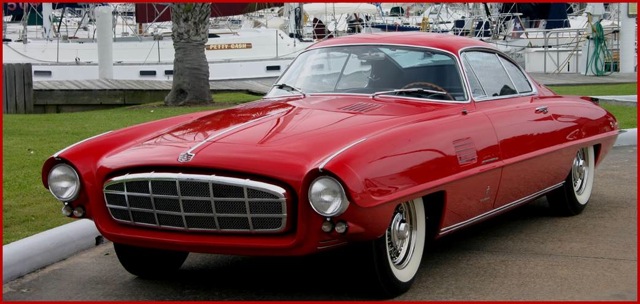
The 1954 De Soto Adventurer
Of all the concept cars ever shown off to a fawning public, one of the coolest has got to be this 1954 Desoto Adventurer II Coupe. It was originally built in 1954, and it sits atop a Chrysler Imperial chassis with a body designed and built by Ghia.
A 54 Desoto recently sold for $1,430,000 at the Barrett-Jackson auction in 2012!
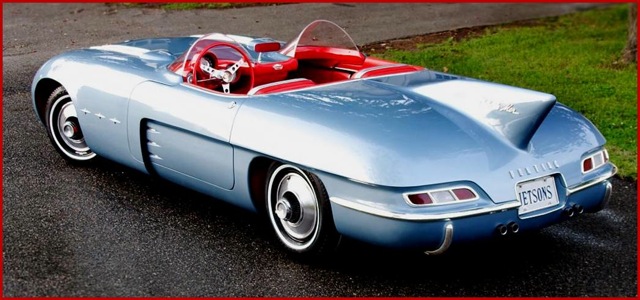
The 1956 Pontiac Club
The 1956 Pontiac Club De Mer was the unique masterpiece of GM's Motorama car show for 1956. The body was made out of anodized brushed aluminum and was a scant 38 inches high. The engine compartment housed a 300 horsepower Stato-Streak V8 engine with dual 4 barrel carburetors. The companion car for the full scale Club De Mer was a quarter scale model, which traveled with the car to all of the auto shows throughout the United States. While the full scale model was destroyed in 1958, the Quarter Scale Model was retained by General Motors and was later motorized by Harley Earl, chief designer of General Motors and given to his grandson, whose first name was tiger, as a peddle car. Thereafter the car went through several hands and was recently purchased and restored by the Bortz Auto Collection.
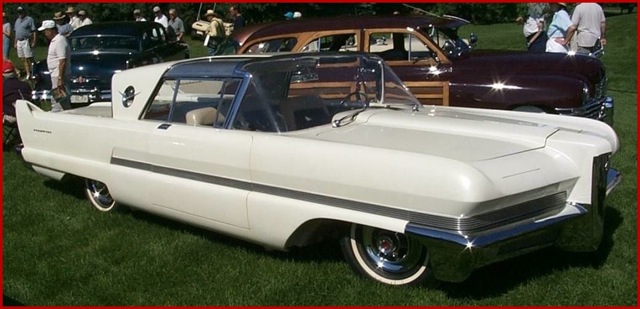
The 1956 Packard Predictor
Perhaps the worst-named concept car of the 1950s was the Packard Predictor. It did little to predict the future of automotive design beyond a couple years, and worse yet, it was a bad joke on the future of Packard itself. Sure, the Predictor's reversed rear window and swivel bucket seats would appear on production cars, but the Edsel-style front bumper helped spell doom for that automaker. Regardless, these features were very 1950s and the package as a whole was certainly wild and awe-inspiring during the jet age. We can't predict the past's future on a path not chosen, but we can't help think what Packard's future might have held had the Predictor design made it to production. It survives.
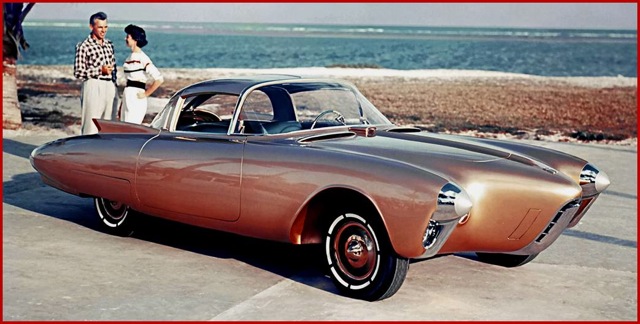
The 1954 Oldsmobile Rocket
If it weren't for the wheels and tires, Oldsmobile's 1956 Golden Rocket might look as though it were a rocket plucked straight from under the wing of a F-94 jet plane and given the plane's cockpit cover. No other 50s dream car took the jet-age theme more seriously than the Golden Rocket. Its three-point nose, rocket-tip rear bumper caps and rounded side panels to tie the front and back together made the Golden Rocket look like, well, a rocket with wheels. There was even a lateral fin on the rear deck for good measure.
While the nose was smooth for good air stream, there was a vent located in the center prow, flanked by projectiles at the tips of the pointed front fenders. As though more jet-age inspiration were necessary, several cockpit controls were placed in the center of the steering wheel. A central console that began on the instrument panel and extended to the console was not unlike that found in today's cars, but the lift-up roof panels for easy entry and egress were very much a jet-age feature of the Golden Rocket.
The metallic gold Golden Rocket was promoted as a "glittering new experimental car by Oldsmobile," but the shine soon wore off. Exactly where this car landed after the 1956 Motorama season is anyone's guess.
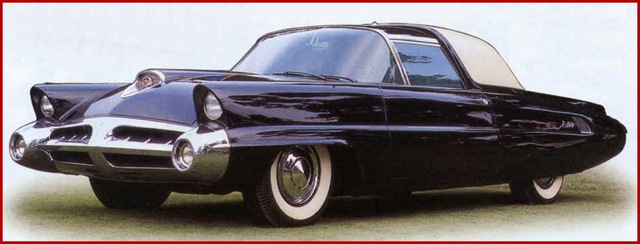
The 1953 Ford X-100
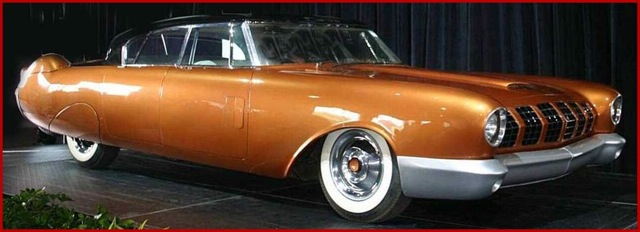
The 1954 Mercury D524
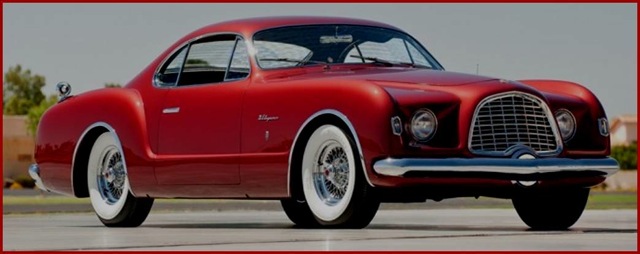
The 1952 Chrysler D'Elegance
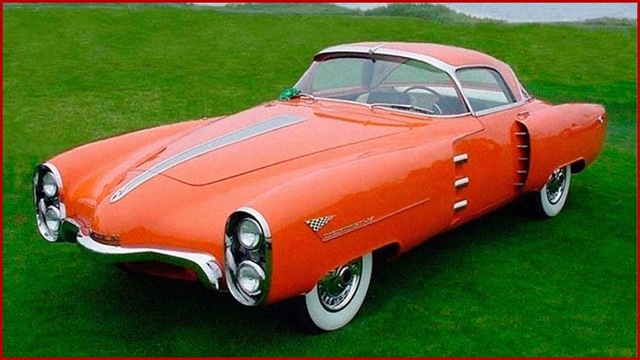
The 1955 Lincoln Indianapolis
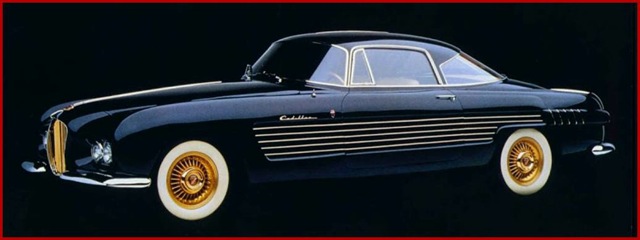
The 1953 Cadillac Ghia
Despite its handsome appearance, only four prototypes of this car were built between 1953 nd 1954.
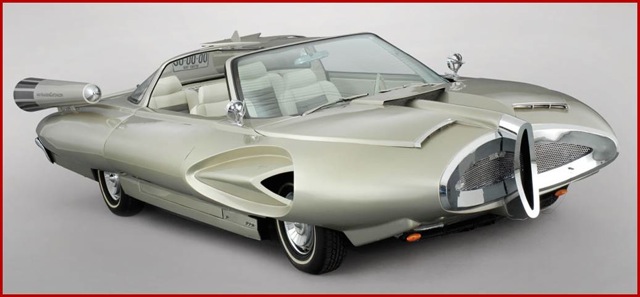
The 1958 Ford X-2000
In the 1950s, automotive magazines were filled with images of space-age cars and visions of the future, and the 1958 Ford X2000 was one of them. the 1958 Ford X2000 is powered by a 352 cu. in. V8 engine that outputs 220bhp and is coupled with an automatic transmission. The car is equipped with an independent front suspension with upper and lower control arms and coil springs and a live axle with semi-elliptic leaf springs rear suspension.
Harley J. Earl (November 22, 1893 - April 10, 1969) was the initial designated "Head of Design" at General Motors, later becoming Vice President, the first top executive ever appointed in Design of a major corporation in American history. He was an industrial designer and a pioneer of modern transportation design. A coachbuilder by trade, Earl pioneered the use of freeform sketching and hand sculpted clay models as automotive design techniques. He subsequently introduced the "concept car" as both a tool for the design process and a clever marketing device.
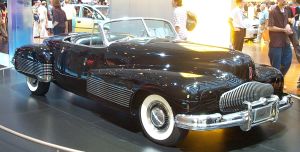 Earl's Buick Y-Job[right] was the first concept car. He started "Project Opel", which eventually became the Chevrolet Corvette, and he authorized the introduction of the tailfin to automotive styling. During World War II, he was an active contributor to the Allies' research and development program in advancing the effectiveness of camouflage.
Earl's Buick Y-Job[right] was the first concept car. He started "Project Opel", which eventually became the Chevrolet Corvette, and he authorized the introduction of the tailfin to automotive styling. During World War II, he was an active contributor to the Allies' research and development program in advancing the effectiveness of camouflage.
Earl Automotive Works was bought by Cadillac dealer Don Lee, who kept Harley Earl as director of its custom body shop.
Lawrence P. Fisher, general manager of the Cadillac division, was visiting Cadillac dealers and distributors around the country, including Lee. Fisher met Earl at Lee's dealership and observed him at work. Fisher, whose automotive career began with coachbuilder Fisher Body, was impressed with Earl's designs and methods, including the use of modeling clay to develop the forms of his designs.
Fisher commissioned Earl to design the 1927 LaSalle for Cadillac's companion marque. The success of the LaSalle convinced General Motors president Alfred P. Sloan to create the Art and Color Section of General Motors, and to name Earl as its first director.
Prior to the establishment of the Art and Color Section, American automobile manufacturers did not assign any great importance to the appearance of automobile bodies. Volume manufacturers built bodies designed by engineers guided only by functionality and cost. Many luxury-car manufacturers, including GM, did not make bodies at all, opting instead to ship chassis assemblies to a coachbuilder of the buyer's choice.
The executives at General Motors at the time, including engineers, division heads, and sales executives, viewed Earl's conceptual ideas as flamboyant and unfounded. Earl struggled to legitimize his design approach against the tradition- and production-oriented executives. As head of the newly formed Art and Color Section in 1927, he was initially referred to as one of the "pretty picture boys", and his Design Studio as being the "Beauty Parlor".
In 1937, the Art and Color Section was renamed the Styling Section. Sloan eventually promoted Earl all the way to the vice president level, making him (to Sloan's knowledge) the first styling person to be a VP at a large corporation.
Harley Earl and Alfred P. Sloan implemented "Dynamic Obsolescence" (essentially synonymous with planned obsolescence) and the "Annual Model Change" (tying model identity to a specific year) to further position design as an engine for the company's product success. These ideas are largely taken for granted today but were unusual at the time.
[source]


New 2015 concept car of BMW is actually the group of projects of the specialized Transportation Design students, that work closely in the partnership with manufacturer BMW itself. Their goal is to create the car for the year 2015 that would be able to involve the language of rapid evolution and also incorporate in itself the BMW brand’s engineering and development philosophy.
The unique image of the concept car BMW ZX-6 was created by Jai Ho Yoo and another student Lukas Vanek. Whether it will be a seriously based concept of not is still to be decided and announced. All we know is that it is a great step towards more sustainable future and also to the further development of BMW brand.
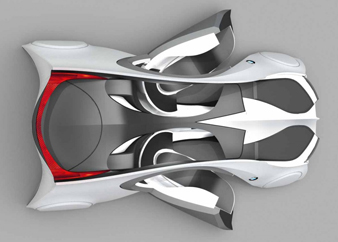
Are we ready for this? Maybe not. As you can see from the vintage demo cars of the 50's and 60s, a great design doesn't always make it to the production floor. Market appeal and the economy often dictates what we will be driving at any given year. Other things like safety (how would this car and the occupants fare in a mundane traffic accident?), convenience (can you fit two people and some luggage?) and price (who can afford one?) will ultimately win over eye-catching design and performance.
Tailfins
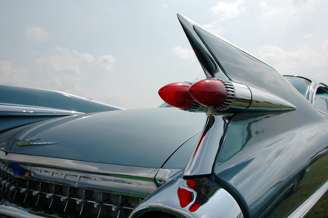
Harley Earl authorized the Frank Hershey design for the 1948 Cadillac, which incorporated the first automotive tailfin. Inspiration for the fins came from the Lockheed P-38 Lightning. But it extended beyond the war, during the age when space rockets captured the popular imagination (1950s and 1960s). The style caught on throughout Detroit and eventually led to competition between Harley Earl and Virgil Exner over the size and complexity of tailfins, culminating with those on the 1959 Cadillac models [above].
57 Chevy: One Prototype That Made It!
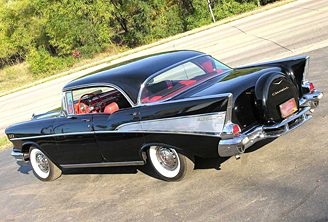
The 1957 Chevrolet [below] is a car which was introduced by the Chevrolet division of General Motors in September, 1956. It was available in three series models: the upscale Bel Air, the mid-range "two-ten", and the "one-fifty". A two-door station wagon, the Nomad was produced as a Bel Air model. An upscale trim option called the "Delray" was available for two-ten 2-door sedans. It is a popular and sought after classic car. These vehicles are often restored to their original condition and sometimes modified. The car's image has been frequently used in toys, graphics, music, movies and television. The '57 Chevy, as it is often known, is an auto icon.
From a numbers standpoint, the '57 Chevrolet wasn't as popular as General Motors had hoped. Despite its popularity, rival Ford outsold Chevrolet for the 1957 model year for the first time since 1935. The main cause of the sales shift to Ford was the fact the '57 Chevrolet had tubeless tires, the first car to have them. This scared away sales to Ford as many people did not initially trust the new tubeless design.
Also Ford's introduction of an all-new body styling that was longer, lower, and wider than the previous year's offerings helped Ford sales. However, the 1957 Ford -- with the exception of the rare retractable hardtop model -- is not nearly as prized by collectors today as the 1957 Chevrolet.
Throughout the 1960s and 1970s, the '57 Chevrolet was a popular used car and highly prized "street machine" or hot rod in 1957 terms. It was the final year of the "shoebox" Chevrolet, as 1958 saw the introduction of a much larger and heavier "X" framed Chevrolet. The ideal size of the '57, combined with its relatively light weight compared to newer full-sized cars, made it a favorite among drag racers. The engine bay was big enough to fit GM's big-block engines, first introduced in 1958 and popularized in the 1960s by the Beach Boys in the song "409".
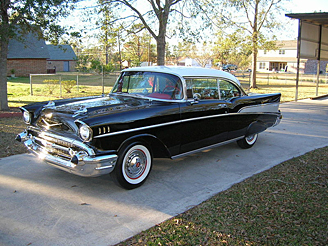
1957 Chevrolet Bel Air Sport Coupé [above]
Heck... enjoy the Beach Boys singing their hit!
(lyrics)
Shes real fine my 409
My 409
Well I saved my pennies and I saved my dimes
(giddy up giddy up 409)
For I knew there would be a time
(giddy up giddy up 409)
When I would buy a brand new 409
(409, 409)
Giddy up giddy up giddy up 409
(giddy up giddy up 409)
Giddy up 409
(giddy up giddy up 409)
Giddy up 409
(giddy up giddy up 409)
Giddy up 40...
Nothing can catch her
Nothing can touch my 409
409 ooooo
(giddy up giddy up oooo)
(giddy up giddy up oooo)
(giddy up giddy up oooo)
(giddy up giddy up)
When I take her to the track she really shines
(giddy up giddy up 409)
She always turns in the fastest times
(giddy up giddy up 409)
My four speed dual quad posi-traction 409
(409, 409, 409, 409)
Giddy up giddy up giddy up 409
(giddy up giddy up 409)
Giddy up 409
(giddy up giddy up 409)
Giddy up 409
(giddy up giddy up 409)
Giddy up 40...
Nothing can catch her
Nothing can touch my 409
(409 409 409 409)
Giddy up 409
(409 409 409 409)
Giddy up 409
(409 409 409 409)